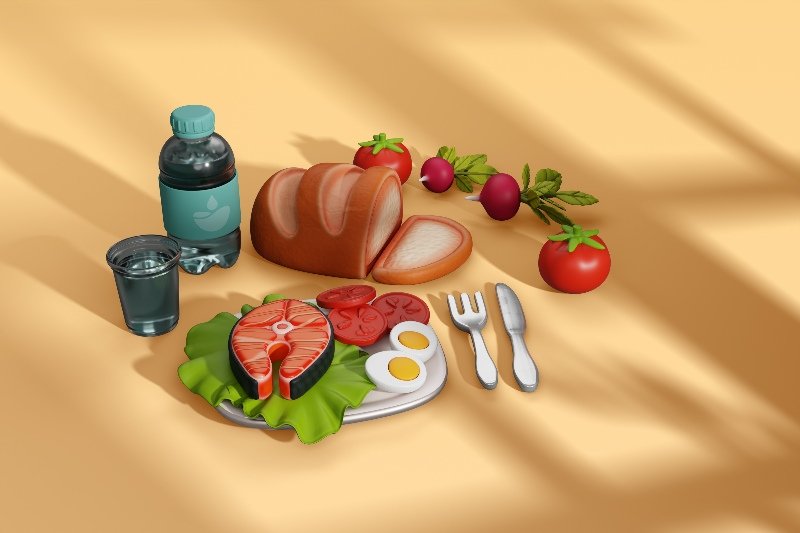Think of your body as a high-powered engine working nonstop, day and night. Just like you wouldn’t put the wrong fuel in your car and expect it to run well, your body needs the right combination of nutrients to function at its best.
After years of working with patients on nutrition, I’ve learned that most people understand they should eat well, but they’re confused about what that actually means. Let me break down the science behind balanced nutrition in a way that’s actually useful for your daily life.
What Makes a Diet Truly Balanced
A balanced diet isn’t about perfect meals or eliminating entire food groups. It’s about getting the right mix of nutrients your body needs to maintain energy, support immune function, and prevent chronic disease.
Core Components Your Body Needs Daily
Macronutrients provide energy and structure:
- Carbohydrates: 45-65% of daily calories
- Proteins: 10-35% of daily calories
- Fats: 20-35% of daily calories
Micronutrients support vital functions:
- Vitamins (13 essential types)
- Minerals (at least 16 required)
- Water (often overlooked but critical)
Why Balance Matters More Than Perfection
| Nutrient Imbalance | Short-term Effects | Long-term Health Risks |
|---|---|---|
| Too few carbs | Fatigue, brain fog, irritability | Nutrient deficiencies, muscle loss |
| Excess simple carbs | Energy crashes, hunger cycles | Type 2 diabetes, obesity, heart disease |
| Insufficient protein | Muscle weakness, slow healing | Muscle wasting, weakened immunity |
| Too little healthy fat | Dry skin, hormone issues | Vitamin deficiencies, inflammation |
| Inadequate vegetables | Digestive issues, low energy | Increased disease risk, poor immunity |
Based on data from the American Journal of Clinical Nutrition and NIH nutrition guidelines
Real Impact of Balanced Nutrition on Your Body
Energy Levels That Actually Last
When you fuel your body with balanced meals, your blood sugar stays steady throughout the day. This means no more 3 PM crashes or needing that third cup of coffee just to function.
What balanced energy looks like:
- Steady alertness from morning to evening
- Ability to exercise without feeling drained
- Better sleep quality
- Consistent mood throughout the day
Immune System Support
About 70% of your immune system lives in your gut. The foods you eat directly influence how well your body can fight off infections and recover from illness.
Nutrients that boost immunity:
- Vitamin C: Commonly available in citrus fruits, strawberries, and bell peppers
- Zinc: Found in foods like lean meats, seeds, nuts, and beans
- Vitamin D: Available through fatty fish, fortified foods, and sunlight
- Probiotics: Found in yoghurt, kefir, fermented vegetables
Disease Prevention Through Diet
The research is clear: what you eat significantly impacts your risk for chronic diseases.
| Health Condition | Dietary Risk Factors | Protective Foods |
|---|---|---|
| Heart Disease | Trans fats, excess sodium, refined sugars | Omega-3 fatty acids, fiber, antioxidants |
| Type 2 Diabetes | Processed foods, sugary drinks, refined carbs | Whole grains, lean proteins, vegetables |
| Certain Cancers | Processed meats, excess alcohol, low fiber | Colorful vegetables, fruits, whole grains |
| Osteoporosis | Low calcium, excess caffeine, inadequate protein | Calcium-rich foods, vitamin D, magnesium |
Building Your Balanced Plate: The Practical Approach
Simple Plate Method
Forget complicated meal plans. Here’s what a balanced meal actually looks like:
Half your plate: Non-starchy vegetables
- Leafy greens, broccoli, peppers, tomatoes, and cucumbers
- They offer essential vitamins, minerals, and fibre while being low in calories.
Quarter of your plate: Lean protein
- Protein-rich options include fish, poultry, eggs, tofu, beans, and lean meats.
- Supports muscle maintenance and keeps you satisfied
Quarter of your plate: Complex carbohydrates
- Brown rice, quinoa, sweet potatoes, whole-grain bread
- Provides sustained energy and B vitamins
Add healthy fats: 1-2 thumb-sized portions
- Avocado, olive oil, nuts, seeds
- Essential for hormone production and nutrient absorption
Portion Sizes That Make Sense
Instead of measuring everything, use your hands as portion guides:
| Food Type | Portion Size | Visual Guide |
|---|---|---|
| Protein | Palm-sized serving | Deck of cards |
| Vegetables | 2 cupped handfuls | Baseball |
| Complex carbs | Cupped palm | Tennis ball |
| Healthy fats | Thumb-sized portion | Dice |
| Fruits | Cupped palm | Tennis ball |
Common Nutrition Mistakes That Sabotage Balance
“All or Nothing” Trap
A lot of people believe they must eat perfectly at every meal. When they slip up, they give up entirely. This creates a cycle of restrictive eating followed by overeating.
Better approach: Aim for balance over perfection. If 80% of your meals are nutritionally balanced, you’re doing great.
Eliminating Entire Food Groups
Unless you have a medical condition that requires it, cutting out entire food groups usually backfires.
What happens when you eliminate:
- All carbs: Cutting out all carbs can lead to low energy, poor brain function, and muscle breakdown.
- All fats: Hormone production decreases, and vitamin absorption drops
- All animal products: Risk of B12, iron, and complete protein deficiencies (unless carefully planned)
Focusing Only on Calories
Calories matter for weight management, but nutrient quality matters more for overall health. Two hundred calories from almonds affects your body very differently from 200 calories from candy.
Example comparison:
| Food | Calories | Protein | Fiber | Key Nutrients |
|---|---|---|---|---|
| 1 oz almonds | 160 | 6g | 4g | Vitamin E, magnesium, healthy fats |
| 1 candy bar (small) | 160 | 1g | 0g | Added sugars, artificial ingredients |
Meal Planning for Balanced Nutrition
Weekly Planning That Actually Works
Sunday prep strategy:
- Cook one grain in bulk (brown rice, quinoa)
- Prepare 2-3 proteins (grilled chicken, beans, hard-boiled eggs)
- Wash and chop vegetables for easy access
- Portion out healthy snacks
Mix and match throughout the week:
- Base + protein + vegetables + healthy fat = balanced meal
- This prevents boredom while ensuring nutrition
Smart Snacking for Balance
Snacks should contribute to your overall nutrition, not just fill you up.
Balanced snack combinations:
- Apple slices with almond butter (carbs + protein + fat)
- Greek yoghurt with berries and nuts (protein + carbs + fat)
- Hummus with vegetable sticks (protein + fiber + healthy fat)
- Whole grain crackers with avocado (complex carbs + healthy fat)
Hydration: The Forgotten Component of Balance
Water is involved in every single function in your body, yet most people don’t drink enough.
How Much Water Do You Actually Need?
Basic formula: Half your body weight in ounces daily
- A 150-pound person needs about 75 ounces (roughly 9 cups)
- Add more if you exercise, live in hot climates, or drink caffeine
Signs of proper hydration:
- Light yellow or clear urine
- Consistent energy levels
- Good skin elasticity
- Regular bowel movements
Beyond Plain Water
You can meet fluid needs through various sources:
- Herbal teas
- Water-rich fruits (watermelon, oranges, berries)
- Vegetables (cucumber, lettuce, tomatoes)
- Soups and broths
Special Considerations for Different Life Stages
Children and Teenagers
Growing bodies have higher nutrient needs per pound of body weight. Focus on:
- Calcium and vitamin D for bone development
- Iron for growth and brain development
- Adequate calories to support growth spurts
- Variety to establish healthy eating patterns
Adults Over 50
Metabolism changes and nutrient absorption can decrease with age:
- Increased need for vitamin B12, calcium, and vitamin D
- More focus on protein to maintain muscle mass
- Higher emphasis on fibre for digestive health
- Consideration of medication-nutrient interactions
Pregnant and Breastfeeding Women
Nutrient needs increase significantly:
- Folic acid for neural tube development
- Iron for increased blood volume
- Calcium for fetal bone development
- Additional calories in the second and third trimesters
Budget-Friendly Balanced Eating
Nutritious Foods That Don’t Break the Bank
| Food Category | Budget-Friendly Options | Cost per Serving |
|---|---|---|
| Protein | Eggs, dried beans, canned tuna | $0.25-$1.00 |
| Vegetables | Frozen mixed vegetables, seasonal produce | $0.50-$1.50 |
| Whole Grains | Oats, brown rice, whole wheat pasta | $0.25-$0.75 |
| Healthy Fats | Peanut butter, olive oil, seeds | $0.50-$1.25 |
| Fruits | Bananas, apples, frozen berries | $0.50-$1.00 |
Money-Saving Strategies
- Buy in season: Seasonal produce costs less and tastes better.
- Use frozen vegetables: Often more nutritious than fresh due to quick freezing after harvest.
- Cook in bulk: Make large batches and freeze portions.
- Compare unit prices: Larger sizes aren’t always better deals.
- Shop sales: Stock up on non-perishable healthy staples when they’re discounted.
Overcoming Common Barriers to Balanced Eating
“I Don’t Have Time”
Quick balanced meals (15 minutes or less):
- Scrambled eggs with spinach and whole-grain toast
- Greek yoghurt with berries and granola
- Tuna salad on mixed greens with avocado
- Bean and vegetable soup with whole-grain crackers
Prep shortcuts:
- Pre-washed salad greens
- Frozen vegetable blends
- Pre-cooked proteins like rotisserie chicken
- Overnight oats for breakfast
“Healthy Food Doesn’t Taste Good”
This often means you haven’t found preparations you enjoy yet.
Flavour enhancement strategies:
- Use herbs and spices liberally
- Try different cooking methods (roasting, grilling, sautéing)
- Add healthy fats for satisfaction and flavour
- Combine familiar flavours with new foods
“My Family Won’t Eat It”
Gradual changes work better than complete overhauls:
- Mix whole-grain pasta with regular pasta, gradually increasing the ratio
- Add vegetables to familiar dishes (pizza, pasta sauce, casseroles)
- Let family members choose from healthy options
- Make healthy versions of favorite foods
Science of Sustainable Change
Why Extreme Diets Fail
Research shows that restrictive diets have a 95% failure rate over 5 years. Your body fights against extreme restrictions through:
- Metabolic adaptation (slower metabolism)
- Increased hunger hormones
- Psychological rebound effects
- Social isolation from food restrictions
Building Lasting Habits
Start small: Change one meal or snack at a time.
Focus on additions: Add vegetables before removing other foods.
Plan for obstacles: Have backup plans for busy days.
Track progress: Note energy levels and how you feel, not just weight.
When to Seek Professional Help
Consider consulting a registered dietitian if you have:
- Chronic health conditions requiring special diets
- History of eating disorders
- Significant food allergies or intolerances
- Persistent digestive issues
- Questions about supplements or special diets
What to look for in a nutrition professional:
- Registered Dietitian (RD) or Registered Dietitian Nutritionist (RDN) credentials
- Experience with your specific health concerns
- An approach that emphasises balance rather than restriction
- Willingness to work with your lifestyle and preferences
Next Steps Toward Better Balance
Balanced nutrition isn’t about following a perfect diet—it’s about making consistent choices that support your health and energy over time.
- Week 1: Focus on adding one serving of vegetables to each meal.
- Week 2: Include a protein source with every meal and snack.
- Week 3: Switch half your refined grains to whole grains.
- Week 4: Add one new healthy fat source to your daily routine
Remember, the goal isn’t perfection. It’s progress. Every balanced meal is a win for your health, regardless of what you ate yesterday or what you might eat tomorrow.
The right diet is one you can maintain long-term without losing energy or well-being. That’s what proper balance looks like—and it’s completely achievable with the right approach.
For evidence-based nutrition guidelines and resources, visit the Academy of Nutrition and Dietetics and the USDA’s MyPlate nutrition guide.

